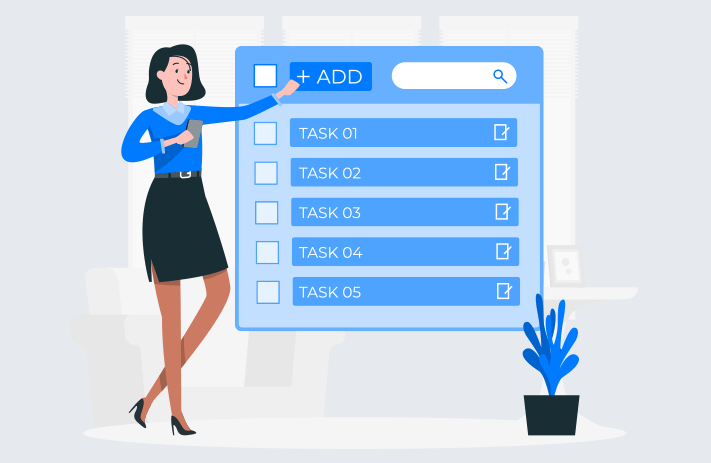
Click the button to start reading
Transform Your Business with Competition Beating Process Optimization Strategies
Picture this: your business running like a well-oiled machine, with every process fine-tuned for maximum efficiency and productivity.
Sounds like a dream, right?
Well, it can become your day-to-day reality at work if you focus on creating a business process optimization strategy.
Efficiency and productivity are the lifeblood of any successful organization. By investing time and effort into understanding your current processes and identifying areas for improvement, you can unlock your business’s true potential.
In this article, we’ll walk you through the essentials of business process optimization, exploring various techniques, tools, and methodologies that can help you transform your operations.

What Is Business Process Optimization?
Business process optimization is all about refining your organization’s workflows and systems to achieve optimal results. It refers to the practice of analyzing, redesigning, and improving existing business processes to enhance efficiency, reduce costs, and ultimately drive better outcomes.
Businesses can streamline their operations and boost overall performance by identifying areas of improvement and implementing changes.
Goals and objectives of process optimization
The primary goal of business process optimization is to create more efficient and effective workflows that support the organization’s strategic objectives. This can involve:
- Reducing waste and redundancies: Eliminating unnecessary steps and tasks that don’t add value to the process.
- Increasing productivity: Improving workflows to enable employees to work more efficiently and achieve better results.
- Enhancing customer satisfaction: Streamlining processes to deliver higher-quality products or services to customers in a timely manner.
- Improving communication and collaboration: Facilitating better communication and collaboration among team members, departments, or partners.
- Supporting innovation and growth: Creating an environment that encourages continuous improvement and enables businesses to adapt to changing market conditions.
Benefits of implementing optimization strategies
Implementing business process optimization strategies can lead to numerous benefits for organizations, including:
- Cost savings: By streamlining operations and eliminating inefficiencies, businesses can reduce expenses and save resources.
- Increased revenue: Enhanced processes can lead to higher productivity and improved customer satisfaction, ultimately driving revenue growth.
- Competitive advantage: A well-optimized business can respond more quickly to market changes and customer needs, staying ahead of the competition.
- Employee satisfaction: Efficient processes can reduce frustration and improve job satisfaction among employees, leading to higher retention and better overall performance.
- Agility and adaptability: A focus on continuous improvement helps organizations stay nimble and adapt to evolving business environments.
By understanding the concept of business process optimization, its goals and objectives, and the potential benefits it can bring, organizations can begin to develop and implement strategies to optimize their operations and achieve greater success.

The Business Process Optimization Steps for Success
Developing a successful business process optimization strategy involves a series of steps designed to help organizations analyze, improve, and refine their operations.
Let’s explore these steps in more detail.
Identifying and analyzing current processes
The first step in developing a business process optimization strategy is to identify and analyze your organization’s current processes.
This involves:
- Listing all essential business processes
- Documenting each process step by step
- Identifying bottlenecks, inefficiencies, and areas for improvement
- Collecting data on process performance, such as time taken, resources used, and costs incurred
Setting optimization goals and objectives
Once you’ve analyzed your current processes, it’s time to set goals and objectives for optimization.
These should be aligned with your organization’s overall strategic objectives and may include:
- Reducing costs
- Increasing productivity
- Enhancing customer satisfaction
- Improving communication and collaboration
- Supporting innovation and growth
Mapping out process improvements
With your goals and objectives in mind, the next step is to map out process improvements.
This involves:
- Identifying potential changes to streamline workflows and eliminate inefficiencies
- Evaluating the potential impact of each improvement on process performance
- Prioritizing improvements based on factors such as cost, feasibility, and potential benefits
- Developing detailed plans for implementing the selected improvements
Implementing and monitoring changes
Once you’ve mapped out your process improvements, it’s time to put them into action.
This involves:
- Communicating the planned changes to relevant stakeholders, such as employees, partners, or suppliers
- Providing necessary training and support to ensure a smooth transition
- Implementing the changes according to the developed plans
- Monitoring the impact of the changes on process performance and comparing the results to your optimization goals and objectives
Continuously refining and optimizing processes
Business process optimization is an ongoing effort that requires continuous refinement and adaptation.
To ensure long-term success, organizations should:
- Regularly review and analyze process performance data to identify new opportunities for improvement
- Stay up-to-date on industry best practices and emerging technologies that could further enhance operations
- Foster a culture of continuous improvement, encouraging employees to identify and suggest process improvements
- Periodically reevaluate optimization goals and objectives to ensure they remain aligned with the organization’s strategic objectives
These steps help businesses to develop and implement a successful business process optimization strategy that drives efficiency, productivity, and overall business growth.

Get Started With These Business Process Optimization Methods
There are several well-established techniques that organizations can use to optimize their business processes. Each approach offers unique benefits and can be tailored to suit an organization’s specific needs and objectives.
Here’s an overview of five popular business process optimization techniques.
Lean methodology
Lean methodology is a popular process optimization technique that focuses on minimizing waste and maximizing value in business processes. Originally developed for the manufacturing industry, Lean principles can be applied to any sector.
Key elements of the Lean methodology include:
- Identifying and eliminating waste: Waste refers to any activity that does not add value to the customer or the organization. Lean methodology emphasizes reducing waste to improve efficiency and productivity.
- Continuous improvement: Lean organizations are always looking for ways to improve and refine their processes, fostering a culture of ongoing learning and growth.
- Respect for people: Lean methodology places a strong emphasis on empowering employees to take ownership of their work and contribute to process improvement efforts.
Six Sigma
Six Sigma is a data-driven optimization technique that aims to reduce process variability and defects. Developed by Motorola in the 1980s, Six Sigma has since been adopted by organizations across various industries.
Key components of the Six Sigma methodology include:
- DMAIC (Define, Measure, Analyze, Improve, Control): This structured problem-solving approach guides teams through the process of identifying issues, analyzing data, implementing improvements, and monitoring results.
- Statistical analysis: Six Sigma relies heavily on statistical tools and techniques to analyze process performance data and identify opportunities for improvement.
- Training and certification: Six Sigma includes a comprehensive training and certification program, with various levels of expertise (Yellow Belt, Green Belt, Black Belt, and Master Black Belt).
Business Process Reengineering (BPR)
Business Process Reengineering (BPR) is a radical optimization technique that involves rethinking and redesigning an organization’s core processes from the ground up.
BPR aims to achieve dramatic improvements in efficiency, effectiveness, and customer satisfaction by:
- Challenging existing assumptions and processes: BPR encourages organizations to question the status quo and consider entirely new approaches to their operations.
- Focusing on customer needs: BPR emphasizes the importance of aligning business processes with the needs and expectations of customers.
- Implementing cross-functional processes: BPR often involves breaking down traditional departmental silos and implementing processes that span multiple functional areas.
Continuous Improvement (Kaizen)
Kaizen, a Japanese term meaning “change for the better,” is a philosophy of continuous improvement that can be applied to business process optimization.
Kaizen encourages organizations to:
- Make small, incremental improvements: Kaizen focuses on making regular, small-scale changes to processes, rather than attempting large-scale overhauls.
- Empower employees: Kaizen emphasizes the importance of involving all employees in the process of continuous improvement, regardless of their role or level within the organization.
- Establish a culture of learning and growth: Kaizen fosters an environment in which employees are encouraged to learn from mistakes, experiment with new ideas, and share their insights with others.
Agile project management
Originally developed for the software development industry, Agile project management has since been adapted for use in various sectors as a process optimization technique.
Agile project management emphasizes:
- Flexibility and adaptability: Agile methodologies prioritize responding to change over following a fixed plan, allowing organizations to adapt their processes as needed.
- Collaboration and communication: Agile teams work closely together, fostering open communication and collaboration across departments and functional areas.
- Iterative progress: Agile processes are divided into short, iterative cycles (often called “sprints”) that allow teams to make incremental improvements and respond quickly to changing circumstances.
Each of these techniques offers unique advantages, and organizations may choose to adopt one or combine elements from multiple approaches to create a tailored business process optimization strategy. Ultimately, the most effective technique will depend on an organization’s specific needs, goals, and culture.

How To Make the Most of Your Business Process Optimization Strategy
A successful business process optimization strategy relies on several key components to ensure its effectiveness. These components work in tandem to maximize efficiency, streamline processes, and ultimately drive growth and success for your organization.
Aligning processes with business goals
The foundation of an effective optimization strategy is ensuring that your processes are aligned with your overarching business goals. This alignment allows for a more focused approach to optimization and ensures that all efforts are directed towards driving the organization towards its objectives.
Establishing clear roles and responsibilities
Clearly defining roles and responsibilities within your organization is essential for successful process optimization. This clarity helps prevent confusion, miscommunication, and duplication of efforts, leading to a more efficient and productive work environment.
Implementing effective communication strategies
Effective communication is crucial for successful optimization efforts. Establishing open channels of communication among team members and departments ensures that everyone is on the same page and working towards the same goals.
Utilizing technology and automation
Embracing technology and automation can greatly enhance the efficiency of your processes. By automating repetitive tasks and streamlining workflows, businesses can save time, reduce human error, and ultimately improve overall productivity.
Measuring and monitoring performance
Regularly tracking and monitoring the performance of your processes is critical to ensure ongoing optimization. By setting key performance indicators (KPIs) and closely monitoring them, you can identify areas for improvement and make data-driven decisions to refine your processes continuously.
Incorporating these key components into your business process optimization strategy can help to create a comprehensive approach to improving efficiency, productivity, and ultimately, the success of your organization.

Examples of Business Process Optimization At Work
In this section, we’ll explore three hypothetical examples of businesses that have successfully implemented business process optimization strategies to tackle their unique challenges.
Each example will highlight the specific steps taken and the positive outcomes experienced by these organizations as they embraced process optimization.
Example 1: Manufacturing company streamlining production processes
Let’s consider WidgetWorks, a manufacturing company specializing in the production of high-quality widgets. They noticed a decline in productivity and an increase in production costs due to inefficiencies in their manufacturing process.
To address these issues, WidgetWorks implemented a business process optimization strategy that included the following steps:
- Analyzing their current production processes and identifying bottlenecks and inefficiencies.
- Implementing Lean methodology to eliminate waste and improve efficiency.
- Introducing automation and technology to streamline production workflows.
- Monitoring key performance indicators (KPIs) to measure the success of their optimization efforts.
As a result, WidgetWorks significantly reduced production costs, improved productivity, and increased customer satisfaction due to shorter lead times and consistent product quality.
Example 2: Retail organization improving inventory management
Next, let’s take a look at TrendyThreads, a retail organization with multiple brick-and-mortar stores. They were struggling with inventory management, leading to stockouts, excess inventory, and ultimately lost sales.
To address these challenges, TrendyThreads implemented a business process optimization strategy focused on improving inventory management:
- Developing a centralized inventory management system to provide real-time visibility into stock levels across all stores.
- Implementing a demand forecasting model to accurately predict customer demand and optimize inventory levels.
- Streamlining communication between stores, suppliers, and the distribution center to ensure timely inventory replenishment.
- Continuously monitoring and adjusting inventory levels based on data-driven insights.
As a result, TrendyThreads reduced stockouts, minimized excess inventory, and ultimately increased overall sales and customer satisfaction.
Example 3: Financial institution enhancing customer service
Lastly, let’s examine MoneyMatters, a financial institution that wanted to enhance its customer service to differentiate itself from competitors. They identified several areas for improvement, including long wait times, inconsistent service quality, and lack of personalization.
MoneyMatters implemented a business process optimization strategy to address these issues:
- Identifying and analyzing the root causes of customer service inefficiencies.
- Implementing an Agile project management approach to quickly test and refine customer service improvements.
- Utilizing technology, such as AI-powered chatbots and customer relationship management (CRM) systems, to streamline and personalize customer interactions.
- Training customer service staff on effective communication and problem-solving techniques.
- Regularly monitoring customer feedback and satisfaction metrics to ensure continuous improvement.
As a result of their optimization efforts, MoneyMatters significantly improved customer service quality, reduced wait times, and increased customer satisfaction and loyalty.
Conclusion
Remember, effective optimization strategies involve aligning processes with business goals, clarifying roles and responsibilities, fostering open communication, leveraging technology, and regularly measuring performance.
Start by identifying and analyzing your current processes, setting clear optimization goals, and mapping out improvements. Don’t forget to continuously monitor and refine your processes, embracing techniques such as Lean, Six Sigma, or Agile project management to streamline your operations.
So, take action now, and embark on your journey towards business process optimization – your organization will thank you for it!
















